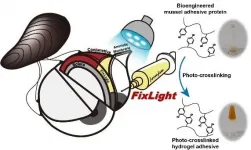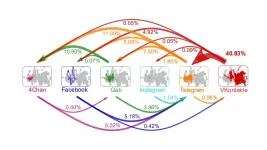(Press-News.org) Sometimes photos cannot truly capture a scene. How much more epic would that vacation photo of Niagara Falls be if the water were moving?
Researchers at the University of Washington have developed a deep learning method that can do just that: If given a single photo of a waterfall, the system creates a video showing that water cascading down. All that's missing is the roar of the water and the feeling of the spray on your face.
The team's method can animate any flowing material, including smoke and clouds. This technique produces a short video that loops seamlessly, giving the impression of endless movement. The researchers will present this approach June 22 at the Conference on Computer Vision and Pattern Recognition.
"A picture captures a moment frozen in time. But a lot of information is lost in a static image. What led to this moment, and how are things changing? Think about the last time you found yourself fixated on something really interesting -- chances are, it wasn't totally static," said lead author Aleksander Holynski, a doctoral student in the Paul G. Allen School of Computer Science & Engineering.
"What's special about our method is that it doesn't require any user input or extra information," Holynski said. "All you need is a picture. And it produces as output a high-resolution, seamlessly looping video that quite often looks like a real video."
Developing a method that turns a single photo into a believable video has been a challenge for the field.
"It effectively requires you to predict the future," Holynski said. "And in the real world, there are nearly infinite possibilities of what might happen next."
The team's system consists of two parts: First, it predicts how things were moving when a photo was taken, and then uses that information to create the animation.
To estimate motion, the team trained a neural network with thousands of videos of waterfalls, rivers, oceans and other material with fluid motion. The training process consisted of asking the network to guess the motion of a video when only given the first frame. After comparing its prediction with the actual video, the network learned to identify clues -- ripples in a stream, for example -- to help it predict what happened next. Then the team's system uses that information to determine if and how each pixel should move.
The researchers tried to use a technique called "splatting" to animate the photo. This method moves each pixel according to its predicted motion. But this created a problem.
"Think about a flowing waterfall," Holynski said. "If you just move the pixels down the waterfall, after a few frames of the video, you'll have no pixels at the top!"
So the team created "symmetric splatting." Essentially, the method predicts both the future and the past for an image and then combines them into one animation.
"Looking back at the waterfall example, if we move into the past, the pixels will move up the waterfall. So we will start to see a hole near the bottom," Holynski said. "We integrate information from both of these animations so there are never any glaringly large holes in our warped images."
Finally, the researchers wanted their animation to loop seamlessly to create a look of continuous movement. The animation network follows a few tricks to keep things clean, including transitioning different parts of the frame at different times and deciding how quickly or slowly to blend each pixel depending on its surroundings.
The team's method works best for objects with predictable fluid motion. Currently, the technology struggles to predict how reflections should move or how water distorts the appearance of objects beneath it.
"When we see a waterfall, we know how the water should behave. The same is true for fire or smoke. These types of motions obey the same set of physical laws, and there are usually cues in the image that tell us how things should be moving," Holynski said. "We'd love to extend our work to operate on a wider range of objects, like animating a person's hair blowing in the wind. I'm hoping that eventually the pictures that we share with our friends and family won't be static images. Instead, they'll all be dynamic animations like the ones our method produces."
INFORMATION:
Co-authors are Brian Curless and Steven Seitz, both professors in the Allen School, and Richard Szeliski, an affiliate professor in the Allen School. This research was funded by the UW Reality Lab, Facebook, Google, Futurewei and Amazon.
For more information, contact Holynski at holynski@cs.washington.edu.
The eye is the first sensory organ that recognizes the presence or shape of an object. The conjunctiva is a thin mucous membrane that covers the front half of the eyeball. It protects the eye by secreting mucus and tears for lubrication, and prevents microorganisms from entering. However, since it is exposed to the air, it is susceptible to damages by microorganisms, bacteria, or dust. In fact, if fibrovascular tissues are left to propagate on its surface, they can lead to diseases like pterygium, which can cause visual deterioration. To treat such conditions, an operation to remove and regenerate the damaged conjunctiva is performed. Recently, a Korean research team has developed a new ...
INDIANAPOLIS - Much needs to be accomplished during the short time a primary care physician sees a patient. A new study from U.S. Department of Veterans Affairs, Regenstrief Institute and IUPUI researchers reports that electronic health records (EHRs) are not rising to the challenges faced by primary care physicians because EHRs have not been designed or tailored to their specific needs. The study, a review and analysis of research on the topic conducted from 2012 to 2020, recommends implementing a human factor approach for the design or redesign of EHR user interfaces.
"The human mind can do many things well. Digesting vast amounts of patient information while multitasking in time-constrained situations ...
Women exposed to higher levels of air pollution during pregnancy have babies who grow unusually fast in the first months after birth, putting on excess fat that puts them at risk of obesity and related diseases later in life, new CU Boulder research shows.
The study of Hispanic mother-child pairs, published this week in the journal Environmental Health, is the latest to suggest that poor air quality may contribute at least in part to the nation's obesity epidemic, particularly among minority populations who tend to live in places with more exposure to toxic pollutants.
About one in four Hispanic youth in the United States ...
ROCHESTER, Minn. -- Artificial intelligence (AI) may offer a way to accurately determine that a person is not infected with COVID-19. An international retrospective study finds that infection with SARS-CoV-2, the virus that causes COVID-19, creates subtle electrical changes in the heart. An AI-enhanced EKG can detect these changes and potentially be used as a rapid, reliable COVID-19 screening test to rule out COVID-19 infection.
The AI-enhanced EKG was able to detect COVID-19 infection in the test with a positive predictive value -- people infected -- of 37% and a negative predictive value -- people not infected -- of 91%. When additional normal control subjects were added to reflect a 5% prevalence of COVID-19 -- similar ...
CORVALLIS, Ore. - Research by Oregon State University suggests a pair of compounds originating from hops can help thwart a dangerous buildup of fat in the liver known as hepatic steatosis.
The findings, published today in eLife, are important because the condition affects roughly one-fourth of people in the United States and Europe. While heavy drinking is often associated with liver problems, people with little or no history of alcohol use comprise that 25%, which is why their illness is known as non-alcoholic fatty liver disease, or NAFLD.
Resistance to insulin, the hormone that helps control blood sugar levels, is a risk factor for NAFLD, ...
COLUMBUS, Ohio - Adults who skip breakfast are likely to miss out on key nutrients that are most abundant in the foods that make up morning meals, a new study suggests.
An analysis of data on more than 30,000 American adults showed that skipping breakfast - and missing out on the calcium in milk, vitamin C in fruit, and the fiber, vitamins and minerals found in fortified cereals - likely left adults low on those nutrients for the entire day.
"What we're seeing is that if you don't eat the foods that are commonly consumed at breakfast, you have a tendency not to eat them the rest of the day. So those common breakfast nutrients become a nutritional gap," said Christopher Taylor, professor of medical dietetics in the College of Medicine at The Ohio State ...
State-of-the-art video microscopy has enabled researchers at WEHI, Australia, to see the molecular details of how malaria parasites invade red blood cells - a key step in the disease.
The researchers used a custom-built lattice light sheet microscope - the first in Australia - to capture high-resolution videos of individual parasites invading red blood cells, and visualise the molecular and cellular changes that occur throughout this process. The research has provided critical new information about malaria parasite biology that may have applications for the development of much-needed new antimalarial medicines.
The research, which was published today in Nature Communications, was led by Ms Cindy Evelyn, Dr Niall Geoghegan, Dr Lachlan Whitehead, ...
Makeup wearers may be absorbing and ingesting potentially toxic per- and polyfluoroalkyl substances (PFAS), according to a new study published today in Environmental Science & Technology Letters. The researchers found high fluorine levels--indicating the probable presence of PFAS--in most waterproof mascara, liquid lipsticks, and foundations tested. Some of the products with the highest fluorine levels underwent further analysis and were all confirmed to contain at least four PFAS of concern. The majority of products with high fluorine, including those ...
Many cosmetics sold in the United States and Canada likely contain high levels of per- and polyfluoroalkyl substances (PFAS), a potentially toxic class of chemicals linked to a number of serious health conditions, according to new research from the University of Notre Dame.
Scientists tested more than 200 cosmetics including concealers, foundations, eye and eyebrow products and various lip products. According to the study, 56 percent of foundations and eye products, 48 percent of lip products and 47 percent of mascaras tested were found to contain high levels of fluorine, which is an indicator of PFAS use in ...
WASHINGTON (June 15, 2021)--Malicious COVID-19 online content -- including racist content, disinformation and misinformation -- thrives and spreads online by bypassing the moderation efforts of individual social media platforms, according to new research published in the journal END ...





